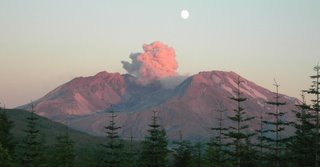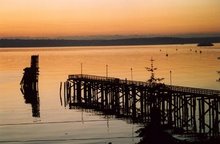Mount St. Helen's (A Visitor's Guide)

The Mt. St. Helen's eruption was a big part of our local history. I actually heard it from the other side of the state. This is really an amazing place to visit. I hear that many of our guests have taken the trek to see the volcano. Here's a brief guide to getting the most out of your visit from those that have gone before you. Also, please click on this link for complete information from the USDA Forest Service. They have a wealth of information on their web site! That said, here are my tips for a trip to the volcano.
1-Allow a lot of time! It's an all day affair. I'm not kidding. It might look like a short trip on the map, but it's absolutely an all day activity. It takes about two hours to get to the first museum from Seattle/Tacoma. From the first museum (which is really cool, by the way) it's still another 90 minutes of mountain roads to reach The Johnson Observatory near the mountain (which also has a fine museum. It's a long winding road, folks. Be prepared. Go really early if you want to get some hiking or take photos. It really worth it, but I can't stress enough how tired you'll be at the end of the day.
2-Check the weather. Overcast conditions are common in this area. Make sure the visibility is good before you go. Check the realtime Mt. Saint Helen's Volcano cam to see weather conditions and visibility. I went once on a cloudy day and couldn't see a dang thing. That's a whole lotta driving for not getting a peek.
3-Bring your hiking shoes. There are many great day hikes in the area. The USDA Forest Service web site has them mapped out. They also list distances and times (driving) between the points of interest. Their site really is a wealth of information. If you are going to see the volcano, read their site thoroughly.
4-Pack plenty of food and water. Though a few travel services do exist in the area, they are few and far between. Pack a full cooler of goodies to make sure you don't go hungry. Seriously, there is nothing here to eat. It's an active volcano with zero 7-11's. If you go hiking, bring emergency food/water/safety equipment. It's a very remote area with little help available if something goes wrong. I don't mean to alarm you, but please prepare accordingly if you are planning a long hike.
5-Bring plenty of layers. You'll be going to a pretty high elevation in the pass and then dropping thousands of feet in elevation in the valleys . It could drop 40 degrees over the course of a few miles. Dress appropriately and be prepared for a wide variety of conditions.
6-Bug Spray. Bring it. Nuff said.
7-Cameras. If you have a panoramic camera/lens, bring it with your other gear. There are amazing photographic opportunities here.
That said,... have a great time! It's really an amazing landscape to witness first hand. With the right time allotment and preparation, this is a great day trip.



No comments:
Post a Comment